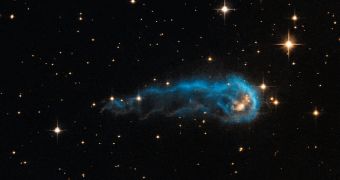Even with the cheapest telescopes, you can see wonderful things if you stare at the night sky. So it's no surprise that astronomers with powerful instruments such as the Hubble Space Telescope are their disposal are finding some wonderful sights.
NASA has published a beautiful image of a giant "caterpillar," a light-year-long pocket of gas that's being shaped by radiation from nearby young stars. But as with all beautiful space photos, sometimes the beauty lies beyond the image and in the processes that created it.
"The caterpillar-shaped knot, called IRAS 20324+4057, is a protostar in a very early evolutionary stage. It is still in the process of collecting material from an envelope of gas surrounding it. However, that envelope is being eroded by the radiation from Cygnus OB2," NASA explained.
The gas cloud should fuel the protostar inside it enough for it to turn into a bright young star, at least as large as our sun.
But because of the great concentration of other large young stars around it, known as the Cygnus OB2, the gas is being pushed away.

 14 DAY TRIAL //
14 DAY TRIAL //